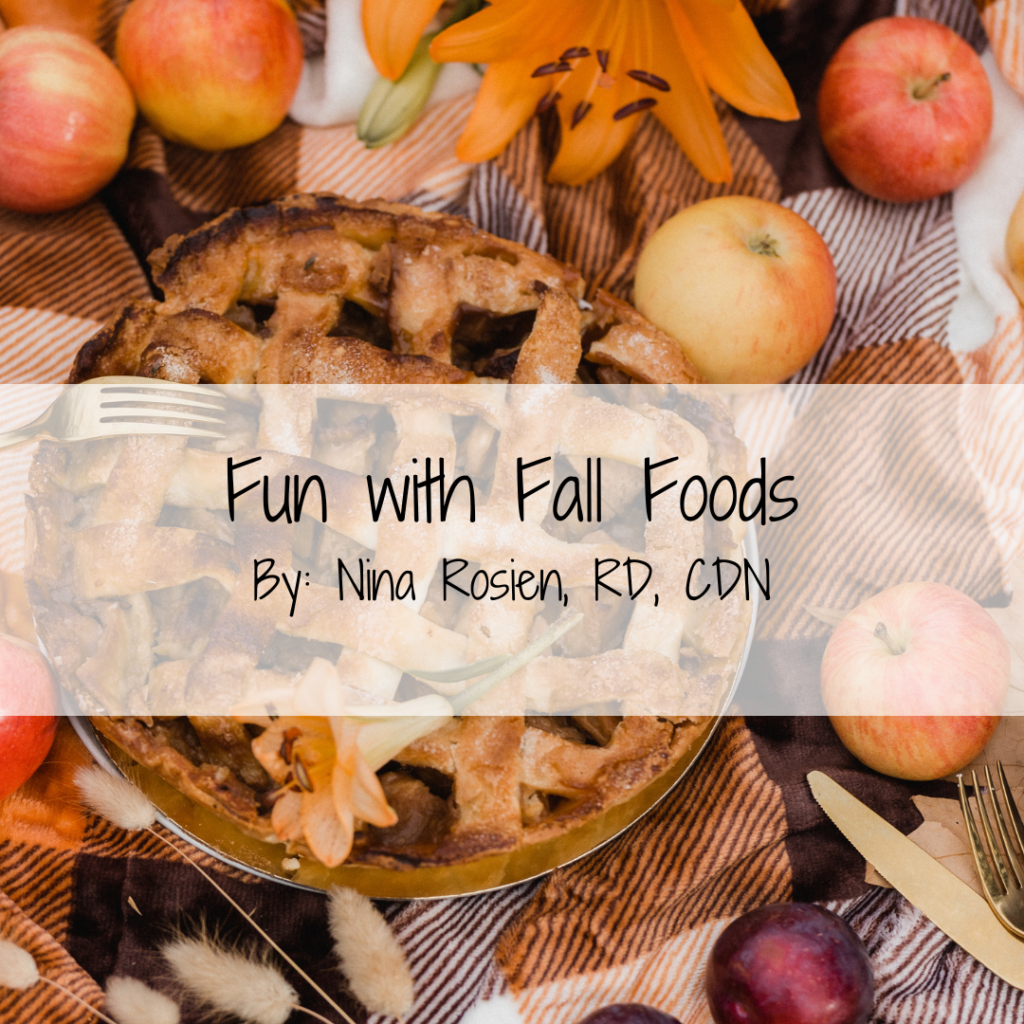
Happy Fall ya’ll! Yes, I admit it, I absolutely LOVE Fall. It’s the perfect season in my opinion. The cooler days, warmer colors, football season, crunchy leaves, crisp air, pumpkin/apple/gingerbread flavored everything – you really can’t go wrong. Eating seasonal foods that sound good to you that time of year can also contribute to satisfaction. It can be as simple as asking yourself, what sounds good on this cool fall day? Chili? Soup? Listening to personal preferences at different times of the year can make food experiences more fun! Let’s look at why we should eat locally & some ideas on how to do so.
Why buy local produce?
- Sustainability – Eating produce seasonally can promote sustainability in food production. Eating locally allows us to support the health of our local ecosystem and its soils. Also, 50% of our fruit and 25% of our vegetables in the United States are imported, contributing to excess transportation which is the number one source of greenhouse gas. Therefore, greenhouse gas emissions are reduced when you buy produce from your local farm!
- Cost effective – When you buy local produce, you cut out a lot of transportation that goes on behind the scenes. When you cut out these companies by buying locally, produce is cheaper. Not to mention, with all the transportation of produce, it can ripen before it even reaches the grocery store! Also, the more abundance of produce, the less the cost. So if you buy fruits and vegetables when it’s in season and plentiful, you’ll likely get a better deal. To buy more local produce you can sign up for a Community Supported Agriculture (CSA), or visit one of the many local farmer’s markets this fall.
- Peak nutrition – Another great bonus is when you buy locally, the produce is allowed to grow and even ripen before it has been picked to be sold. This creates a higher nutritional value due to the fruit or vegetable ripening on the plant. Additionally, because the produce is getting to your plate sooner than if it was coming from South America, there is less nutrient degradation.
- Connect to our local roots – Buying locally helps us support local farmers as well, and builds a connection with locals in the area. It also allows us to be closer to nature, knowing we can use produce that’s grown right in our hometown!
- Local fall foods include: green beans, beets and beet greens, broccoli, brussels sprouts, cabbage, cauliflower, carrots, celery, collard greens, corn, eggplant, fennel, kale, lettuce, leeks, lima beans, onions, peas, peppers, potatoes, scallions, spinach, squash, swiss chard, tomatoes, turnips, apples, grapes, pears, raspberries, and watermelon.
One of the first things that come to mind when fall shows up is pumpkin spice. Don’t get me wrong, the pumpkin spice blend is one of the warmest fall spices of them all but I also encourage you to try some of the spices that go under the radar this time of year:
- Nutmeg – Nutmeg is one of those unique spices that can be used both savory and sweet. One of my favorite ways to use it is to toss some butternut squash with a pinch of nutmeg and cinnamon, in addition to avocado oil and roast it in the oven. This can be a great way to get a variety of vegetables, especially if you’re looking for a different way of flavoring roasted vegetables!
- Cardamom – This is a warm spice that can be combined with cinnamon to add a whole new depth of flavor. I recently stumbled upon an old cook book by Molly Yeh, and she incorporates cardamom in several ways, both sweet and savory. One of my favorite ways she does it is Hawaij, specifically for coffee. Hawaij is a blend of cardamom, ginger, cinnamon and cloves, and is intended to enhance the flavor of any coffee. Another great way that you can use cardamom on a more day-to-day basis is a chai chia pudding – a great source of protein, fats, and fiber. Yemeni soup is another excellent way to incorporate Hawaij and cardamom.
- Herbs De Provence – This is a blend of herbs that hail from a specific region in France. I LOVE a good spice blend, the aroma of Herbs de Provence is what drew me to it. You can season animal proteins with it, especially red meats that are common during the fall season. If you prefer the plant based variety, you can add it to most soups and roasted vegetables. Piquant Post has an excellent Herbed Quiche Lorraine recipe featuring Herbs De Provence.
- For more specifics on nutrition and spices, check out Spices and Herbs 101.
As for food, fall means comfort. As the weather gets cooler, we tend to crave and search for warm, soothing foods. Listening to these preferences allows us to have more fun and enjoyment in foods. Here are some of my favorites when it comes to fall comfort foods, and how we can elevate them:
- Curry – This is one of my favorite ways to have fall comfort food. There are so many different spices and types of curry out there, that it’s easy to avoid bordem. They can be versatile too! You can practically add any vegetable in them and make it work. Some of my favorite curry recipes are Japanese curry or Burmese curry.
- Carrots and potatoes are commonly used in Japanese curry, try changing it up by using sweet potatoes, honey nut squash, or butternut squash to increase the variety of produce. You can do this for most stews as well.
- Incorporate vegetables you don’t often use, or try a curry which has spices you don’t use in most cooking to widen the variety of nutrients and phytochemicals you are taking in.
- Shepards Pie – When I was in Ireland, shepherd’s pie was everywhere. I actually avoided getting it for the longest time because it’s something that can be made in the states. But when you’re walking in downtown Dublin and it’s cold and rainy, shepherd’s pie sure hits the spot! It’s warm and cozy – and you can “zazz” it up with some different vegetables and meats.
- Add a can of rinsed canned lentils in with the beef or bison part of the pie to increase fiber intake.
- Add mashed cauliflower with potatoes for the top layer to increase the non-starchy vegetables in the dish, or switch it up by using sweet potatoes or squash.
- Chili – The standard chili or chili con carne includes ground meat, beans, and a tomato base. It’s also one of those meals that I grew up having every fall, and you can stick it in the crockpot and let it cook for hours – and smell the spices all day long!
- Some of the ways you can add produce is to throw a pepper and onion in the food processor. Pulse the produce until it gets to a slightly fine, and saute this in with the ground meat. This helps increase the vegetable intake but does not change the consistency of the chili too much.
- Alternatively, you can leave the onions and peppers chunky and add other veggies like carrots or zucchini for a heartier more vegetable heavy version of chili.
- To increase the protein, try using bone broth instead of vegetable stock. Bone broth includes collagen which is the most abundant protein in the body, and it adds a depth of rich flavor too.
- Casseroles – I love a good casserole, you literally throw things into a dish and put it in the oven. One challenge can be finding casseroles with more vegetables for the added fiber and nutrient kick.
- Try adding a variety of roasted veggies to your next casserole dish, and bake as you normally do.
- Add some color to your casserole – make an effort to choose 2-3 different colored vegetables to saute and mix in to your favorite casserole before baking it
- Try using brown rice or quinoa instead of white rice- remember this may adjust the cooking time.
- Throw in some extra beans (chickpeas, black beans, cannellini beans, kidney beans, etc.) as a way to increase fiber and nutrients.
What are your favorite fall foods? Share your recipes in the comments below!
Resources:
https://alissarumsey.com/intuitive-eating-recipes/
https://jamiegeller.com/guides/how-to-use-hawaij-for-coffee/


